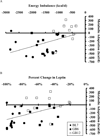Metabolic adaptation following massive weight loss is related to the degree of energy imbalance and changes in circulating leptin
- PMID: 25236175
- PMCID: PMC4236233
- DOI: 10.1002/oby.20900
Metabolic adaptation following massive weight loss is related to the degree of energy imbalance and changes in circulating leptin
Erratum in
-
Erratum: Metabolic adaptation following massive weight loss is related to the degree of energy imbalance and changes in circulating leptin.Obesity (Silver Spring). 2016 Oct;24(10):2248. doi: 10.1002/oby.21634. Epub 2016 Aug 10. Obesity (Silver Spring). 2016. PMID: 27670403 Free PMC article. No abstract available.
Abstract
Objective: To measure changes in resting metabolic rate (RMR) and body composition in obese subjects following massive weight loss achieved via bariatric surgery or calorie restriction plus vigorous exercise.
Methods: Body composition and RMR were measured in 13 pairs of obese subjects retrospectively matched for sex, body mass index, weight, and age who underwent either Roux-en-Y gastric bypass surgery (RYGB) or participated in "The Biggest Loser" weight loss competition (BLC).
Results: Both groups had similar final weight loss (RYGB: 40.2 ± 12.7 kg, BLC: 48.8 ± 14.9 kg; P = 0.14); however, RYGB lost a larger proportion of their weight as fat-free mass (FFM) (RYGB: 30 ± 12%, BLC: 16 ± 8% [P < 0.01]). In both groups, RMR decreased significantly more than expected based on measured body composition changes. The magnitude of this metabolic adaptation was correlated with the degree of energy imbalance (r = 0.55, P = 0.004) and the decrease in circulating leptin (r = 0.47, P = 0.02).
Conclusions: Calorie restriction along with vigorous exercise in BLC participants resulted in preservation of FFM and greater metabolic adaption compared to RYGB subjects despite comparable weight loss. Metabolic adaptation was related to the degree of energy imbalance and the changes in circulating leptin.
© 2014 The Obesity Society.
Conflict of interest statement
No authors have conflicts of interest.
Figures



References
-
- Buchwald H, Oien DM. Metabolic/bariatric surgery Worldwide 2008. Obes Surg. 2009;19:1605–1611. - PubMed
-
- Adams TD, Gress RE, Smith SC, Halverson RC, Simper SC, Rosamond WD, et al. Long-term mortality after gastric bypass surgery. N Engl J Med. 2007;357:753–761. - PubMed
-
- Ashrafian H, le Roux CW, Darzi A, Athanasiou T. Effects of bariatric surgery on cardiovascular function. Circulation. 2008;118:2091–2102. - PubMed
Publication types
MeSH terms
Substances
Grants and funding
- P30 DK058404/DK/NIDDK NIH HHS/United States
- P30 DK072476/DK/NIDDK NIH HHS/United States
- ZIA DK075076/ImNIH/Intramural NIH HHS/United States
- R01 DK070860/DK/NIDDK NIH HHS/United States
- K01 DK089005/DK/NIDDK NIH HHS/United States
- P30 DK020593/DK/NIDDK NIH HHS/United States
- UL1 RR024975/RR/NCRR NIH HHS/United States
- DK20593/DK/NIDDK NIH HHS/United States
- DK058404/DK/NIDDK NIH HHS/United States
- K01DK89005/DK/NIDDK NIH HHS/United States
- 1 UL1 RR024975/RR/NCRR NIH HHS/United States
- UL1 TR000445/TR/NCATS NIH HHS/United States
- R01-DK070860/DK/NIDDK NIH HHS/United States
- R01 DK091748/DK/NIDDK NIH HHS/United States
LinkOut - more resources
Full Text Sources
Other Literature Sources
Medical
Research Materials

